Do you have a 1935 Wheat penny and wonder if it could be worth something more than just one cent?
Whether you’re hoping to strike it rich, or you’re a collector looking to add one to your collection, you’re in the right place.
We’ve put together this guide to break down the 1935 Wheat penny’s value, its history, design features, and what makes certain examples stand out — including errors that could fetch you a nice payday.
While many of these coins are heavily circulated and often worth no more than face value, a well-preserved uncirculated coin in mint state condition can be surprisingly valuable.
Let’s take a closer look!
1935 Wheat Penny Value Chart (Red Coins Only)
| Mint Mark | MS60 | MS63 | MS64 | MS65 |
|---|---|---|---|---|
| 1935 (No Mint Mark) | $8 | $18 | $22 | $36 |
| 1935-D | $9 | $22 | $32 | $50 |
| 1935-S | $18 | $50 | $65 | $90 |
💡 Note: These values apply to coins graded “red” by professional grading services. Red coins are generally more desirable and valuable than red-brown or brown examples.
Next up: we’ll explore what sets these coins apart, how to tell their condition, and what rare varieties or errors to look out for. Let’s keep going!
The History of the 1935 Wheat Penny
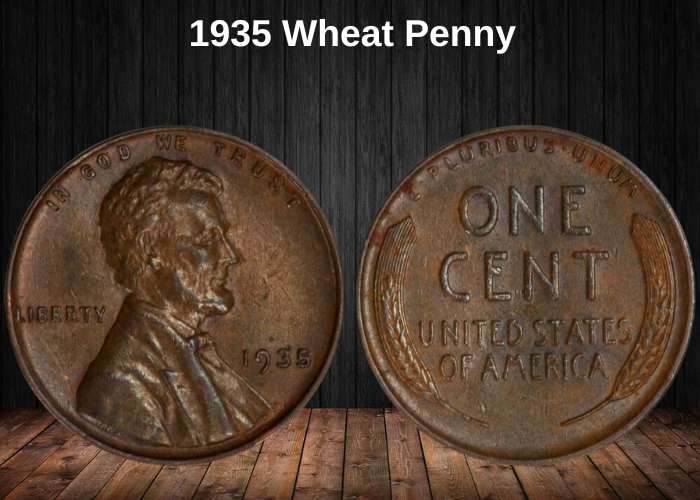
The 1934 Wheat Penny is part of the Lincoln cent series, which was first introduced in 1909 to honor the 100th birthday of President Abraham Lincoln. Designed by Victor David Brenner, the coin features Lincoln’s profile on the obverse (front) and two wheat ears on the reverse, symbolizing prosperity. This design remained in use until 1958, making it one of the longest-running U.S. coin designs.
Minted during the recovery period following the Great Depression, the 1934 Wheat Penny reflects a time of significant economic and social change in the United States. While no major events are directly tied to this particular penny, it represents a stable continuation of American coinage during a challenging era.
The 1934 penny was struck at two locations: Philadelphia (no mint mark) and Denver (marked with a “D”), with tens of millions of coins produced in total. Because of the relatively high mintage numbers, the 1934 Wheat Penny is not considered rare, but well-preserved examples in mint condition are still sought after by collectors.
In summary, the 1934 Wheat Penny is a historical piece that captures the resilience of the American spirit during tough times, making it a meaningful addition to any coin collection.
Features of the 1935 Wheat Penny
The Obverse of the 1935 Wheat Penny

The obverse of the 1935 Wheat Penny features a right-facing portrait of President Abraham Lincoln, elegantly depicted wearing a suit and a bow tie.
Above Lincoln’s head, the motto “IN GOD WE TRUST” is boldly inscribed, symbolizing national faith. To the left of the portrait appears the word “LIBERTY”, while the date “1935” is positioned on the right, just in front of Lincoln’s chest.
Reverse of the 1935 Wheat Penny
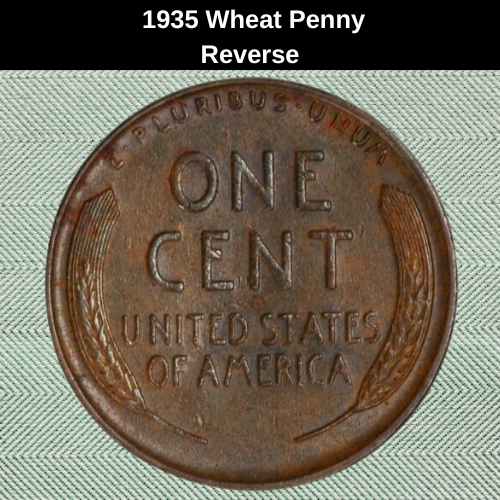
The reverse of the 1935 Lincoln Wheat penny keeps things clean and classic, just like the obverse.
On this side, you’ll find the coin’s signature design element: two curved wheat ears, one on each side of the coin. That’s what gives the “Wheat penny” its nickname.
At the very top, along the inner edge, the Latin motto “E PLURIBUS UNUM” arches gracefully. It translates to “Out of many, one,” referencing the unity of the states.
Centered between the wheat stalks is the denomination — “ONE CENT” — boldly struck in capital letters. Just below that sits “UNITED STATES OF AMERICA”, grounding the design with national pride.
It’s a minimal but iconic layout that stood strong for 50 years before being replaced — and it’s part of what makes these coins so recognizable and collectible today.
Other Features of the 1935 Wheat Penny
The 1935 Wheat Penny has a diameter of 19.00 millimeters and weighs approximately 3.11 grams. It’s composed of 95% copper and 5% tin and zinc, giving it the classic reddish-brown tone characteristic of early Lincoln cents. The coin features a plain edge.
These pennies were struck at three U.S. Mint facilities: Philadelphia, Denver, and San Francisco.
- Coins from Denver bear a “D” mint mark on the obverse, just below the year.
- Those from San Francisco carry an “S” mint mark in the same position.
- Pennies minted in Philadelphia have no mint mark, either on the obverse or reverse.
1935 Wheat Penny Grading
When evaluating 1935 Wheat pennies — or any from the series — collectors should focus on uncirculated examples, as these carry the most value and appeal.
To qualify as uncirculated, the coin should display consistent, unbroken luster from edge to edge. Any interruption in the shine can indicate wear, instantly lowering the grade.
On the obverse, pay special attention to:
- Lincoln’s jawline and cheek – these are common wear points.
- His beard and the coat’s front edge – look for sharp detail without smoothing.
On the reverse:
- Check the inscription “ONE CENT” for a frosty appearance and raised, crisp lettering.
- Look across the field for even luster.
- Inspect the wheat stalks – the grains should be sharply defined, with no flattening or smoothing.
Grading Scale
| # | Grade |
|---|---|
| 1 | Basal State-1 |
| 2 | Fair |
| 3 | Very Fair |
| 4–6 | Good |
| 7–10 | Very Good |
| 12–15 | Fine |
| 20–30 | Very Fine |
| 40 | Extremely Fine |
| 50 | About Uncirculated |
| 60 | Mint State |
| 65 | Mint State Gem |
| 70 | Perfect Mint State |
Tip: Refer to professional grading guides or services like PCGS or NGC to get the most accurate valuation. Knowing your coin’s grade is essential to determining its true market value.
1935 Wheat Penny Value Guides
The majority of 1935 Wheat pennies are worth around their face value. However, brown and brown-red coins are generally less valuable than their red counterparts, which are highly sought after by collectors.
There are three different types of the 1935 Wheat penny:
- 1935 No-Mint Mark Wheat Penny (produced in Philadelphia)
- 1935-D Wheat Penny (produced in Denver)
- 1935-S Wheat Penny (produced in San Francisco)
Now, let’s explore the value of each type.
1935 No-Mint Mark Wheat Penny Value
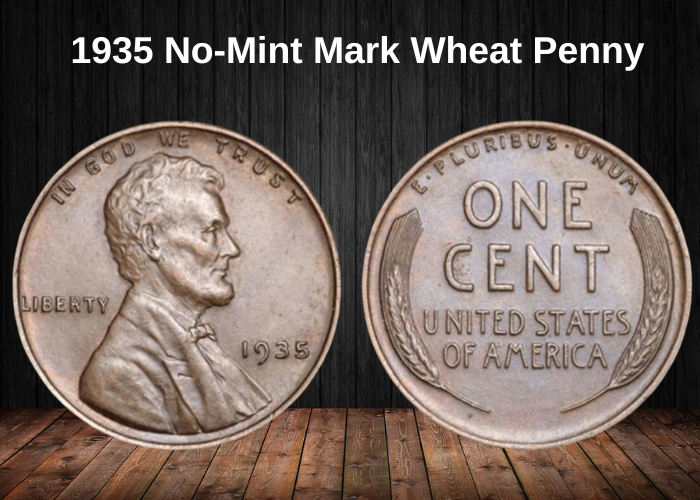
The Philadelphia Mint produced approximately 245,388,000 1935 Wheat pennies. Due to the high mintage, these coins are still relatively easy to find, despite their age.
Since most of these pennies were circulated, many of the coins you’ll encounter are well-worn, meaning their value is generally close to face value.
Value Breakdown for 1935 No-Mint Mark Wheat Penny:
- Circulated (Brown): These coins typically sell for anywhere between $0.05 and $2.
- Uncirculated: Even in Mint State conditions, they remain relatively affordable:
- MS65: Around $15
- MS66: Up to $25
Fully Red Coins:
- MS65 Red: These can be worth up to $36.
- MS68 Red: Extremely rare, and could command premium prices, reaching as high as $8,000.
The most expensive 1935 no-mint mark Wheat penny ever sold was at an auction in 2022, where it fetched a staggering $55,813. This coin remains the highest-priced example in the 1935 series, setting a new benchmark for the value of these pennies.
1935-D Wheat Penny Value
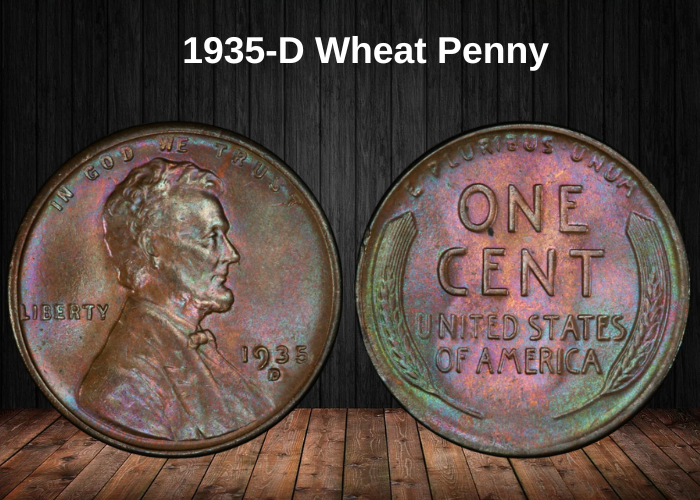
The Denver Mint produced 47,000,000 Wheat pennies in 1935, making it the second-highest mintage after Philadelphia. Due to the use of old working dies, many of the 1935-D wheat pennies were not well-struck, which, combined with the large mintage, significantly lowers their value.
Value Breakdown for 1935-D Wheat Penny:
- Brown Circulated: These coins typically sell for around $0.10 to $2.75.
- Uncirculated Red Coins: Fully red specimens will fetch a much higher price:
- MS65 Red: Typically valued around $50.
- MS68 Red: This grade is extremely rare and can fetch as much as $13,000.
The most expensive 1935-D wheat penny recorded was graded MS67(Red) and sold for $4,080 at a Stack’s Bower auction in 2018, according to the Professional Coin Grading Service (PCGS).
1935-S Wheat Penny Value
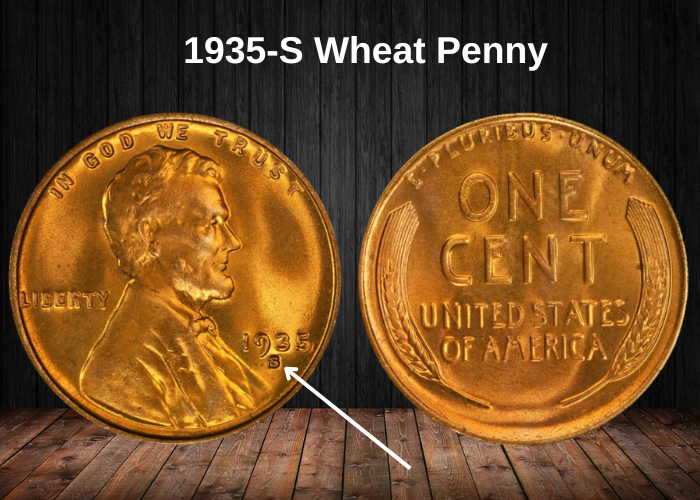
The San Francisco Mint produced the lowest mintage in 1935, with 38,702,000 Wheat pennies, though this number is still quite large compared to other years. These 1935-S wheat pennies are relatively common and affordable, but they often show a weak strike due to worn dies. Finding a coin with a strong strike is ideal for this series.
Value Breakdown for 1935-S Wheat Penny:
- Circulated Coins: These typically range from $0.10 to $6.50, which is slightly more than their no-mint mark and Denver counterparts.
- Mint State Coins: Even MS65 examples are fairly affordable, typically costing around $90.
- Full Red Coins: These are extremely rare in this series, and as expected, their value is significantly higher:
- MS67 Red: A high-quality coin at this grade can command at least $7,500.
Despite the low mintage, the 1935-S wheat penny is still quite common, but red, well-struck specimens in high grades are rare and highly valuable.
Rare 1935 Wheat Penny Errors List
1935 Wheat Penny on A Dime Planchet Error
The 1935 Wheat Penny on a Dime Planchet Error is a highly sought-after minting error among collectors. This occurs when a 1935 wheat penny design is struck on a dime planchet, which is much smaller than the intended penny planchet. As a result, the design elements don’t fit properly, creating a distinctive and odd-looking coin.
This error is particularly popular with collectors, and prices can go as high as $500 for a coin with this type of error. The value can increase even more if the coin is in better condition or mint state.
If you come across one of these rare errors, it could be a great addition to your collection or even a profitable sale!
1935 Struck Through Wheat Penny Error
A struck-through error occurs when a small object, such as dirt or grease, gets between the planchet and the working die, resulting in an impression being left on the coin. In the case of struck-through grease errors, the grease can obscure parts of the design, leading to missing or partial design elements on either the obverse or reverse of the coin.
For the 1935 wheat penny series, these struck-through grease errors are especially popular due to the dramatic effect they have on the design, which makes them particularly interesting to collectors.
If you own a struck-through 1935 wheat penny, it could be worth around $150 depending on the condition and the severity of the error.
1935 Off-Center Strike Wheat Penny Error
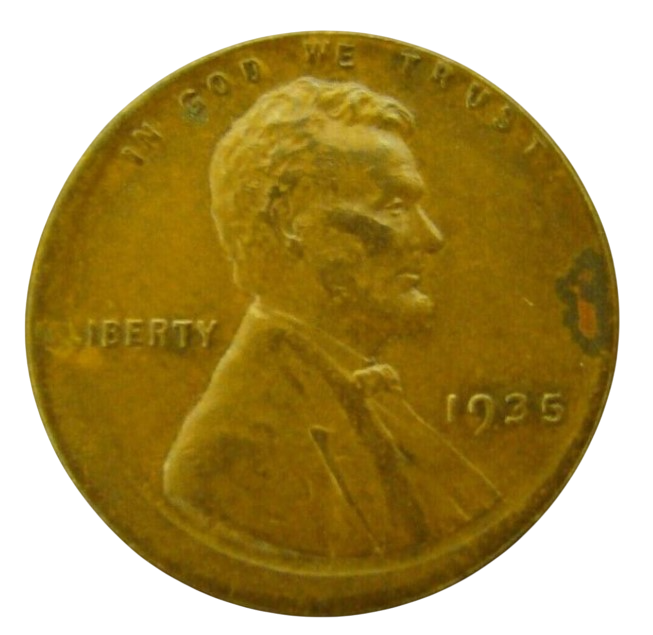
Off-center strikes are another type of error that collectors highly value, often willing to pay significant amounts for coins with this misalignment.
An off-center strike occurs when the striking die or planchet is not properly aligned, causing the design elements to be struck off-center on the coin. This results in a portion of the design being missing from the coin, which can vary in severity.
The more of the design that is missing, the more valuable the coin is. For example, an off-center strike with at least 50% of the design missing is more sought after and could be worth up to $50.
If you happen to own a 1935 off-center strike wheat penny, this could be a valuable addition to your collection, especially if the error is pronounced!
1935 Lamination Wheat Penny Error
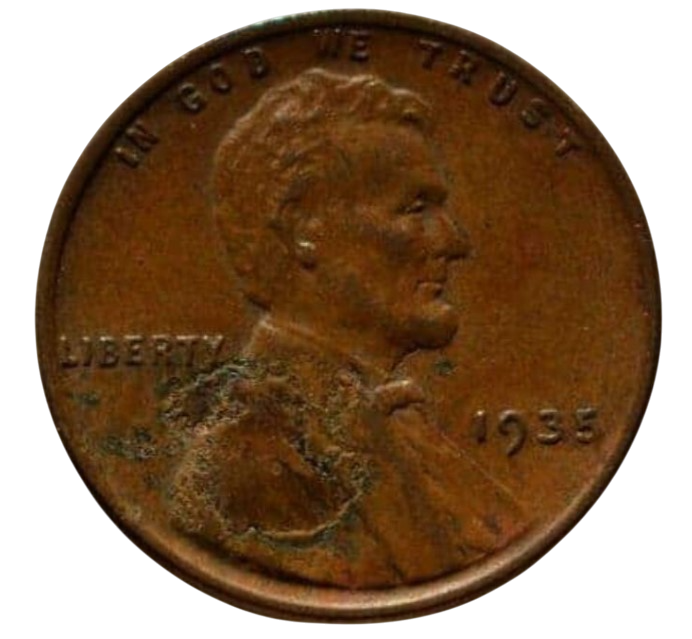
Lamination errors are another intriguing flaw that can increase a coin’s value. These occur when impurities or contaminants in the metal cause the surface of the coin to crack, split, or flake—a process known as metal separation along the horizontal plane.
You’ll often spot a lamination error by the way the coin’s surface appears to peel or lift, sometimes resembling a flaking patina. This gives the coin a distinctive, rugged appearance that many collectors find interesting.
If you come across a 1935 wheat penny with a lamination error, it could be worth up to $50, depending on the size, location, and visibility of the flaw.
1935 Doubled Die Wheat Penny Error
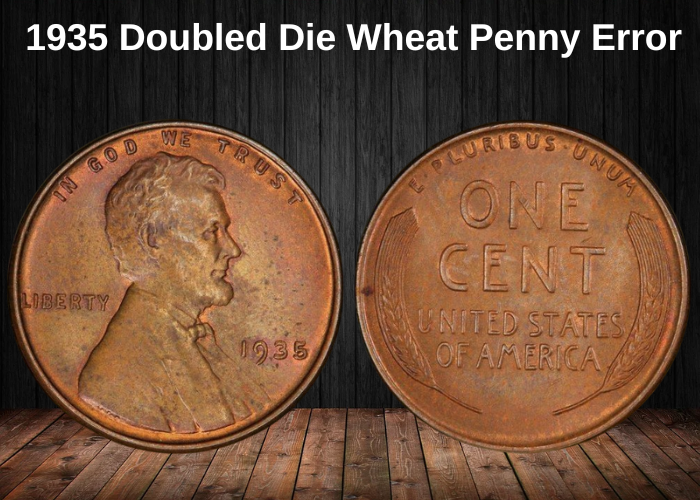
Doubled die errors are among the most well-known and sought-after minting mistakes, especially by collectors who love variety coins. These occur when the design on the hub or die is imprinted more than once, but with a slight misalignment. This results in visible doubling of inscriptions, numbers, or images on the coin.
In the 1935 wheat penny series, doubling has been observed both on the obverse and reverse:
- On the obverse, you might notice doubling on:
- Lincoln’s beard
- The date (1935)
- The motto IN GOD WE TRUST
- On the reverse, doubling may appear around:
- E PLURIBUS UNUM
- UNITED STATES OF AMERICA
It’s also not uncommon to see doubling around the mint mark, often referred to as a re-punched mint mark (RPM) or a fill-in error if grease partially obscures it during striking.
While this entry mistakenly refers to a 1936 doubled die as the example, a 1935 doubled die wheat penny can still fetch a solid $80 or more, especially if the doubling is strong and the coin is in high-grade condition. Coins in mint state with dramatic doubling could go for much higher values at auction.
Where to sell your penny?
Now that you know the value of your penny, you might be wondering where to sell it. Don’t worry: here’s a guide to some of the best online platforms where you can easily sell your coins, along with their advantages and disadvantages.
Discover the best platforms for selling coins online (pros and cons).
FAQS
1. How does the 1935 Wheat Penny reflect the economic recovery of the United States?
The 1935 Wheat Penny was minted during a time of gradual economic recovery following the Great Depression. As the New Deal policies began to stimulate the economy, demand for coinage increased. The high mintage numbers—over 245 million from Philadelphia—reflect this uptick in commerce and the reactivation of industrial production across the country.
2. Which mints produced the 1935 penny, and how do mint marks affect rarity and desirability?
Three U.S. Mints produced the 1935 Wheat Penny:
- Philadelphia (no mint mark): 245,388,000 minted
- Denver (D): 47,000,000 minted
- San Francisco (S): 38,702,000 minted
While the Philadelphia coin is the most common, 1935-D and especially 1935-S examples are more desirable in high grades. The 1935-S RD in MS66–MS67 is considerably scarcer and more valuable due to lower survival rates in pristine condition.
3. What are the most valuable conditions and designations for a 1935 Wheat Penny?
The highest premiums are paid for uncirculated coins with:
- High grades (MS65 to MS67)
- Red (RD) color designation
- Exceptional strike and minimal marks
For example:
- A 1935-S MS67 RD can reach $1,000+ in auctions.
- A 1935-D MS66 RD often fetches $200–$300, depending on eye appeal.
- Brown and Red-Brown versions are worth much less, but still sought after in high grades.
4. Are there any notable varieties or errors associated with the 1935 Wheat Penny?
Yes! Collectors should look for:
- Re-punched mint marks (RPMs) on the 1935-D and 1935-S
- Die cracks or cuds on both obverse and reverse
- Double die obverse (DDO) varieties—rare, but some exist
- Off-center strikes and broadstrikes
Varieties authenticated by PCGS, NGC, or ANACS can significantly boost the coin’s market value.
5. How does strike quality vary among the 1935 Wheat Pennies?
The Philadelphia strikes are generally sharp due to newer dies and better production quality. In contrast, some 1935-S and 1935-D coins may exhibit softer strikes, particularly in Lincoln’s hair and the wheat stalks. Well-struck coins from these mints in high grade are harder to find, increasing their value.
6. What collecting strategies work best for the 1935 Wheat Penny series?
Here are three strong strategies:
- Build a three-coin mint set (P, D, S) in MS65 RD or better.
- Focus on RPM or DDO varieties with certification.
- Seek coins with clean surfaces, strong strikes, and rich red color.
This approach combines completeness with investment value, appealing to both registry collectors and long-term investors.
7. Is the 1935 Wheat Penny a good investment for future value appreciation?
Yes—especially the 1935-S in MS66+ RD. While lower-grade examples are common and affordable, top-tier coins are in limited supply and growing demand. As more collectors pursue full high-grade Wheat sets, coins like the 1935-D and 1935-S in premium condition are poised to appreciate steadily over time.



















































